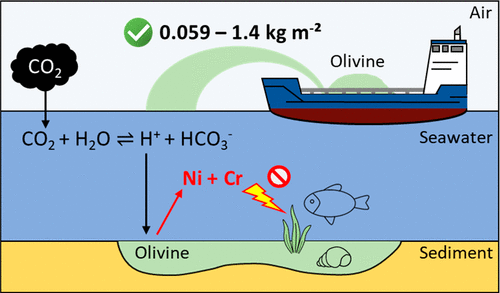当前位置:
X-MOL 学术
›
Environ. Sci. Technol.
›
论文详情
Our official English website, www.x-mol.net, welcomes your feedback! (Note: you will need to create a separate account there.)
Deriving Nickel (Ni(II)) and Chromium (Cr(III)) Based Environmentally Safe Olivine Guidelines for Coastal Enhanced Silicate Weathering
Environmental Science & Technology ( IF 11.4 ) Pub Date : 2021-08-31 , DOI: 10.1021/acs.est.1c02974 Gunter Flipkens 1 , Ronny Blust 1 , Raewyn M Town 1
Environmental Science & Technology ( IF 11.4 ) Pub Date : 2021-08-31 , DOI: 10.1021/acs.est.1c02974 Gunter Flipkens 1 , Ronny Blust 1 , Raewyn M Town 1
Affiliation

|
Enhanced silicate weathering (ESW) by spreading finely ground silicate rock along the coastal zone to remove atmospheric carbon dioxide (CO2) is a proposed climate change mitigation technique. The abundant and fast-dissolving mineral olivine has received the most attention for this application. However, olivine contains nickel (Ni) and chromium (Cr), which may pose a risk to marine biota during a gigaton-scale ESW application. Herein we derive a first guideline for coastal olivine dispersal based on existing marine environmental quality standards (EQS) for Ni and Cr. Results show that benthic biota are at the highest risk when olivine and its associated trace metals are mixed in the surface sediment. Specifically, depending on local sedimentary Ni concentrations, 0.059–1.4 kg of olivine m–2 of seabed could be supplied without posing risks for benthic biota. Accordingly, globally coastal ESW could safely sequester only 0.51–37 Gt of CO2 in the 21st century. On the basis of current EQS, we conclude that adverse environmental impacts from Ni and Cr release could reduce the applicability of olivine in coastal ESW. Our findings call for more in-depth studies on the potential toxicity of olivine toward benthic marine biota, especially in regard to bioavailability and metal mixture toxicity.
中文翻译:

导出基于镍 (Ni(II)) 和铬 (Cr(III)) 的环境安全橄榄石海岸增强硅酸盐风化指南
通过沿沿海地区散布精细研磨的硅酸盐岩以去除大气中的二氧化碳 (CO 2 ) 来增强硅酸盐风化 (ESW)是一种提议的气候变化缓解技术。丰富且快速溶解的矿物橄榄石在此应用中受到了最多的关注。然而,橄榄石含有镍 (Ni) 和铬 (Cr),在十亿吨级的 ESW 应用过程中,这可能对海洋生物群构成风险。在此,我们根据现有的镍和铬海洋环境质量标准 (EQS) 推导出沿海橄榄石扩散的第一个指南。结果表明,当橄榄石及其相关微量金属混合在表层沉积物中时,底栖生物群的风险最高。具体而言,根据当地沉积 Ni 浓度,0.059–1.4 kg 橄榄石 m –2可以在不给底栖生物群带来风险的情况下供应海床。因此,全球沿海 ESW在 21 世纪只能安全隔离 0.51-37 Gt 的 CO 2。根据当前的 EQS,我们得出结论,Ni 和 Cr 释放对环境的不利影响会降低橄榄石在沿海 ESW 中的适用性。我们的研究结果呼吁对橄榄石对底栖海洋生物群的潜在毒性进行更深入的研究,特别是在生物利用度和金属混合物毒性方面。
更新日期:2021-09-21
中文翻译:

导出基于镍 (Ni(II)) 和铬 (Cr(III)) 的环境安全橄榄石海岸增强硅酸盐风化指南
通过沿沿海地区散布精细研磨的硅酸盐岩以去除大气中的二氧化碳 (CO 2 ) 来增强硅酸盐风化 (ESW)是一种提议的气候变化缓解技术。丰富且快速溶解的矿物橄榄石在此应用中受到了最多的关注。然而,橄榄石含有镍 (Ni) 和铬 (Cr),在十亿吨级的 ESW 应用过程中,这可能对海洋生物群构成风险。在此,我们根据现有的镍和铬海洋环境质量标准 (EQS) 推导出沿海橄榄石扩散的第一个指南。结果表明,当橄榄石及其相关微量金属混合在表层沉积物中时,底栖生物群的风险最高。具体而言,根据当地沉积 Ni 浓度,0.059–1.4 kg 橄榄石 m –2可以在不给底栖生物群带来风险的情况下供应海床。因此,全球沿海 ESW在 21 世纪只能安全隔离 0.51-37 Gt 的 CO 2。根据当前的 EQS,我们得出结论,Ni 和 Cr 释放对环境的不利影响会降低橄榄石在沿海 ESW 中的适用性。我们的研究结果呼吁对橄榄石对底栖海洋生物群的潜在毒性进行更深入的研究,特别是在生物利用度和金属混合物毒性方面。

























 京公网安备 11010802027423号
京公网安备 11010802027423号